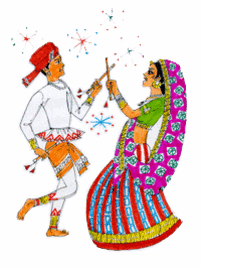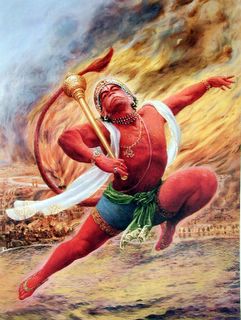The second Durga Shakti is Brahamcharini. Brahma that is who observes penance(tapa) and good conduct. Here "Brahma" means "Tapa". The idol of this Goddess is very gorgeous. There is rosary in her right hand and Kamandal in left hand. She is full with merriment. One story is famous about her. In previous birth she was Parvati Hemavati the daughter of Himvan. Once when she was busy in games with her friends. Naradaji came to her and predicted seeing her Palm-lines that, "You will get married with a naked-terrible 'Bhole baba' who was with you in the form of Sati, the daughter of Daksh in previous birth. But now you have to perform penance for him." There upon Parvati told her mother Menaka that she would marry none except Shambhu, otherwise she would remain unmarried. Saying this she went to observe penance. That is why her name is famous as tapacharini - Brahmacharini. From that time her name Uma became familiar.
Saturday, October 08, 2005
The Different Forms of Durga
The second Durga Shakti is Brahamcharini. Brahma that is who observes penance(tapa) and good conduct. Here "Brahma" means "Tapa". The idol of this Goddess is very gorgeous. There is rosary in her right hand and Kamandal in left hand. She is full with merriment. One story is famous about her. In previous birth she was Parvati Hemavati the daughter of Himvan. Once when she was busy in games with her friends. Naradaji came to her and predicted seeing her Palm-lines that, "You will get married with a naked-terrible 'Bhole baba' who was with you in the form of Sati, the daughter of Daksh in previous birth. But now you have to perform penance for him." There upon Parvati told her mother Menaka that she would marry none except Shambhu, otherwise she would remain unmarried. Saying this she went to observe penance. That is why her name is famous as tapacharini - Brahmacharini. From that time her name Uma became familiar.
Tuesday, October 04, 2005
Navratri Garba-Raas in Gujarat

Gujarat, during the 9th century, was divided into four regions: Saurashtra, Kachchh, Aanara and Laat (south Gujarat). Raas, Garba, Hudo, Tippani are the dance forms of Saurashtra, while Dangi of Dharampur and Holi Nritya from Kawant are attributed to Laat. Garba, Garbi and Bhavai are the dances from Aanarta (north Gujarat), while Siddi Dhamal, Matukadi, Ged-do are original dances of Kachchh. Ideally, two circles formed by men and women move in clockwise and anti-clockwise directions with two sticks called dandiyas held in their hands. The song sung on the occasion is essentially an amorous one. Raas is a very energetic, colourful and playful dance providing opportunity for acting and exchanging messages through eye contact. It is no wonder that many romances bloom during Navaratri and hence the popularity of the dance among the younger generation.
Garbi - Originally men use to perform this dance. It was on the way back from a battle that the victorious army would start dancing to couplets and amorous songs sung by the Charanswar, or the narrators who used to go to the front to raise the spirit during the battle by singing songs of valour. The dance was characteristic for its forceful movements which would fascinate viewers. Today, however, even females participate in the dance.
Hudo - It is the dance of the Bharwads, the shepherd community. The idea of the dance originated from sheep fights. The movements of two sheep ramming their heads is duplicated in the dance in which the dancers clap hands in a forceful and rhythmic manner.
Tippani - Many dance forms evolved from daily routine, and Tippani is one of them. It is the dance form of the labourers who are breaking stones or levelling the ground to break the monotony of the work. Females perform this dance with sticks in their hands which they strike on the ground to the beats of the drum.
Dangi - A dance form of the tribals from Dang, it is performed by both men and women. Dhol and pawri are the accompanying instruments of the dance which is highlighted by gymnastic skills. The strength and power of the dancers is depicted by the movement and the formation of pyramid spirals.
Dharampur - A dance which derives its name from the area. A tribal dance in which men paint their bodies and dance with weapons. Women join in dressed in colourful outfit.
Holi Nritya - A dance performed during Holi by the tribals of the eastern ghats of Gujarat. The dancers are dressed in peacock feathers on their head and waist and dance through the streets.
Siddi Dhamal - A unique dance style of Kachchh. The dancers dance with two thin sticks exhibiting their art and skill while dancing.
Ged-Do - Dance forms in this style of dance from Kachchh exhibit a complicated footwork by moving in a peculiar style akin to the movement of a horse in the game of chess. The dance also has a peculiar drum beat.
Matukadi - A female dance form from Gujarat, it is a very graceful one in which the dancers dance in a circular form in pairs.
Bhawai - This folk form enjoys the reputation of being the most entertaining style of dance from north Gujarat. It was on the verge of extinction after independence.
Navratri - Nine Nights of Fun!
The Devi Mahatmya and other texts invoking the Goddess who vanquished demons are cited.
The day after Navratri i.e. the 10th day after Ashwina, is Dussera which celebrates the victory of lord Rama over Ravana. Ravana is burnt in effigy, often giant dummies of Ravana stuffed with fireworks are shot with arrows until they blow up before a large, applauding audience.
